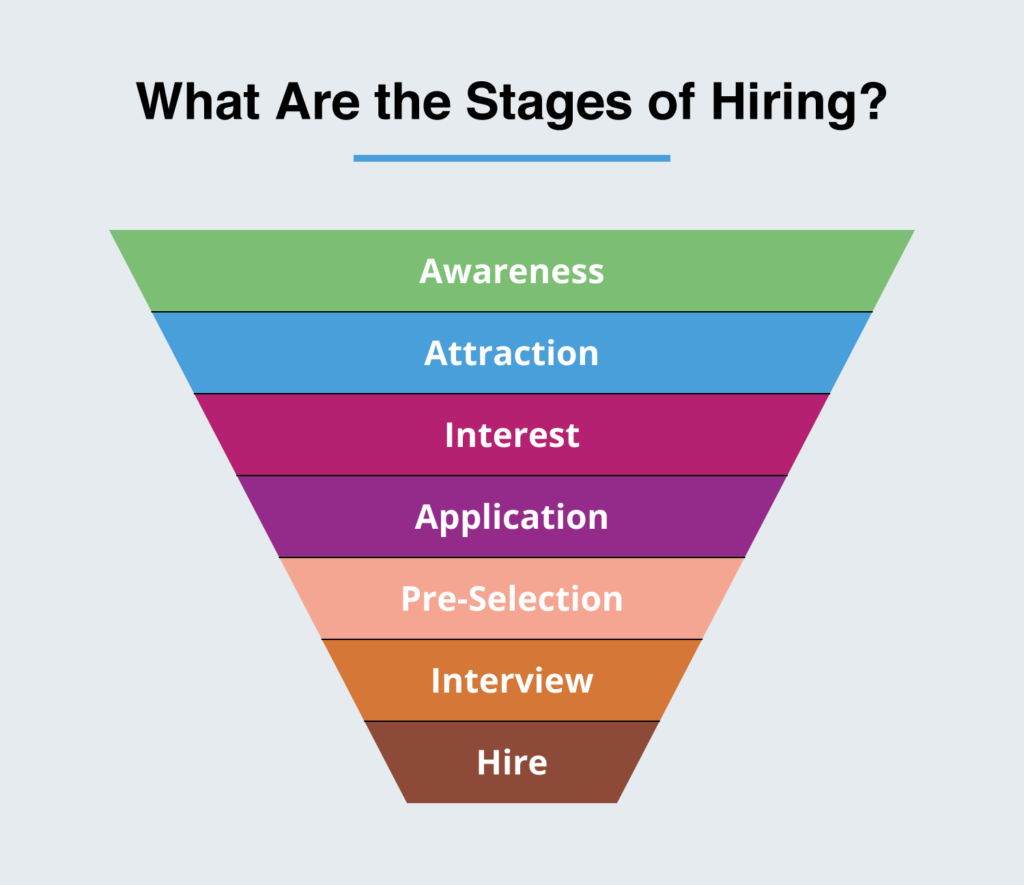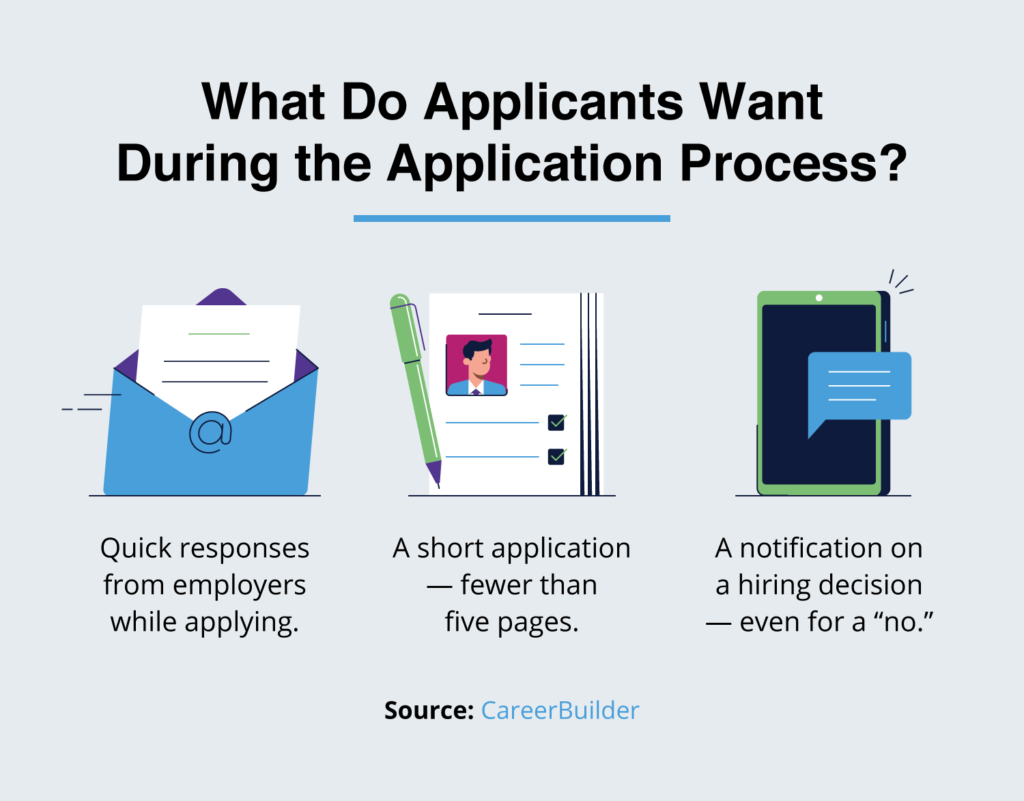What do hiring and dating have in common? It’s all about finding the one. And once you’ve found your perfect match, you don’t want to let them get away.
That’s where an effective hiring funnel comes in. A hiring funnel, also known as a recruitment funnel, can help you lay out your hiring process from top to bottom to make sure it’s streamlined, effective, and successful at attracting the candidates you’re looking for.
What Is a Recruitment Funnel?
A recruitment funnel is a framework you follow for your hiring process. The funnel covers the entire recruiting process from the moment you post your job description to when your new hire signs their offer letter.
Think of it this way: Just like a funnel gets smaller as matter goes through it, so does your candidate pool. In the hiring funnel, the large number of potential employees will become smaller and smaller with each step, leading to your new hires.
Why Is a Recruitment Funnel Important?
There are a lot of considerations to make and steps to take when hiring. An efficient hiring funnel breaks down this long process into manageable steps and makes sure that you’re prepared every step of the way. This helps the hiring managers not only navigate the complex recruiting process but also ensures that applications coming in are from qualified applicants that could be successful at the company.
The Seven Stages of the Hiring Funnel: Recruiting Process Flowchart

The recruitment funnel gives a top-to-bottom overview of the hiring process. Each of these steps is crucial to narrowing down the candidate pool and picking the best applicants.
The steps of the hiring funnel are the following:
- Awareness. Build your brand and make sure applicants know who you are and what you do. Hop on social media to connect with both your customer base and applicant pool.
- Attraction. Write a job description that will make employees want to work at your company and post it on relevant job boards and networking sites. List your perks and a little bit about your culture as well as the job’s tasks.
- Interest. Be prepared to field questions from potential applicants. You can also reach out to past applicants or employees to discuss any negative feelings they have before they leave your business a negative review.
- Application. Make your application easier by eliminating any unnecessary steps and optimizing it for different devices like phones and tablets. Once the applicant hits “submit,” let them know it’s received with an auto-reply.
- Pre-Selection. Consider creating a skills quiz or questionnaire that is unique to your company. This will help weed out any under-qualified candidates while keeping potential hires engaged.
- Interview. Work to eliminate biases in your interviewing process by developing a standardized interview and creating an interview panel if your team has the bandwidth.
- Hire. Create a personalized, impactful offer letter that will make your chosen candidates excited to accept a job with your company.
How To Build an Effective Hiring Funnel
Building an effective hiring process can help you pick the right candidates every time.
Focus on Branding and Community Outreach
A strong logo and color scheme is important — but your brand should go much deeper than that. To truly draw in candidates, your branding should tell a story about who you are and what you do. Using your About page or blog posts, build your brand by creating your own personal style and voice.
Tip: Use social media platforms like Twitter or Instagram to showcase your company culture and connect with potential hires.
Write an Effective Job Description
Your job posting should be accessible and attractive to potential hires while still giving an adequate overview of the qualifications and responsibilities for the position. Use short, clear sentences and keep the posting as brief as possible. Be clear about the experience you want your hires to have, what their experience at the company will be like, and how much you’re going to pay them.
Tip: Remove gendered language from your job posting — it’ll get you more applicants.
Advertise on Relevant Job Sites
Having a large number of candidates isn’t always a good thing — especially when the bulk of those applications aren’t a good fit for your posting. Make sure most of the people who see your job posting are going to be a good fit by posting it on relevant trade job boards, in targeted ads, or on your social media.
Tip: Accepting employee recommendations or recruiting specific people is a good way to make sure applicants are qualified. In fact, 88% of employers said internal referrals lead to top-notch candidates.
Streamline Your Application Process

You may have seen comments about how it’s inconvenient to upload a resume and then still have to fill in a form with your employment information. This might be taking more of a toll than previously thought: 60% of candidates will abandon a job application if the process is too convoluted.
Tip: 70% of job seekers also prefer applications that are fewer than five pages, so shorten your process where you can.
Include Opportunities for Communication Early On
Sometimes high-value requirements aren’t easy to spot on a one-page resume. Skills like clear communication, empathy, and self-direction are incredibly important traits. Sending a short survey requiring text-entry answers allows candidates to showcase their communication skills early on. You also can include specific questions tailored to your team to determine whether they align with your company culture and values.
Eliminate Interview Bias
Unconscious biases can seep into your hiring process and impact which candidates you choose without you knowing it. Everything from thinking a candidate in a nicer suit is more responsible to deciding a candidate is smarter based on their alma mater, race, or gender can subtly shift your hiring process and make you pass over great hires.
Work to eliminate hiring bias by practicing blind hiring and obscuring candidate information from resumes or online forms, training your recruiting team about bias, and implementing panel interviews.
Tip: Conduct your initial screening via chatbot instead of a phone call so you don’t make judgments about a person’s accent or vocabulary.
Measure the Success of Your Recruitment Strategy
Like most things in business, your talent acquisition funnel most likely won’t be fully baked when it comes out of the oven. But with tweaks over time, you can get it to a place where every hire is a win.
Measure your recruiting funnel metrics like the number of accepted offers, candidates who stay with the company, and number of qualified applicants to see how you can course correct.
Tip: If a large number of your applicants are not qualified for your position, that shows that you need to work on your job description and look for more relevant job boards for posting.
How Companies Can Benefit From a Global Hiring Funnel
Global hiring comes with many advantages, including more opportunities to hire diverse and new markets to grow into. But it also deepens your potential candidate pool. So for those hiring abroad, a recruitment funnel is a necessity. An effective funnel can help take that large number of prospective employees and single out those that will be successful.
The global talent acquisition funnel will look like any other, with the added caveat that candidates will come from all over the globe.
To help sort through labor laws and hiring regulations in each country you might hire in, a globalization partner can step in to help.
Metrics To Measure Your Candidate Funnel
Measuring your hiring success with recruiting funnel metrics can help you make the adjustments needed to hire successfully.
Brand Awareness
Brand awareness measures how well people know your company and its mission. This could mean that someone will see your job posting, recognize your company name, and be excited to apply.
You can measure brand awareness by looking at your social media follower count, launching a survey, or using Google Trends to see how often people are searching for your company.
Candidate Screening
As applications come in, measure each candidate’s qualifications and relevance for the job. Are they what you’re looking for? Is each application complete and strong? If not, you may need to tweak some parts of your recruitment funnel. Look at your job posting, where you’re posting your openings, and how intensive your application process is.
Applicant Source
Where do your qualified applicants come from? Here’s an example: If 90% of your prospective employees navigate to your careers page from LinkedIn, you may not need to spend a large amount of your recruiting budget on Facebook ads. Ask candidates how they found your posting and continue to devote resources and money to the avenues that actually attract good hires.
Offer Acceptance Rate
Like we said, hiring is a little bit like dating. Once you’ve put in the time and money and found the one, it can burn to get rejected in the final stages. If most of your job offers come back declined, that means that there’s a hiccup in your hiring process. You may want to look at your interview process, job posting, or candidate experience to pinpoint where things are going awry.
Diversity in Hires
Diverse workforces have been proven to boost team morale and productivity. So if all of the candidates who make it through your funnel look, think, and behave the same, you might want to shake things up.
Measure how many of your hires are different genders, races, ages, sexual orientations, or religions, and how many are parents, have disabilities, or come from different backgrounds. If the number is low, devote more resources to diverse hiring.
Time and Cost of Each Hire
Hiring can eat up a large amount of resources. But an effective funnel should aim for the time and cost of each hire to be on the lower end. To measure time and cost per hire look at:
- Time. The average number of days between posting a job description and receiving a signed offer letter.
- Cost. Adding internal and external recruiting costs, then dividing that number by the total number of hires.
If your time to hire is above the average of about 20 to 30 days and your cost per hire is over the average of about $4,000, you should work to streamline your recruitment process. You can do this by creating a strategic workforce plan and cutting out some extra steps in your funnel.
Ready To Hire?
Hiring is tricky business, but even more so when you’re doing it abroad. That’s why an employer of record can help you find, hire, and take care of your global employees. Contact us to see how we can help with hiring and onboarding.
And for more information on maximizing your hiring funnel, check out the following infographic.

Topic:
HR Strategies



